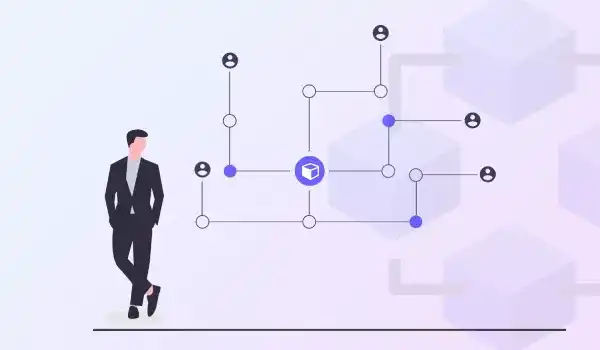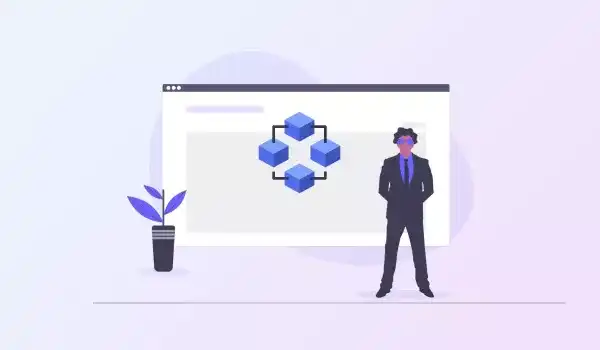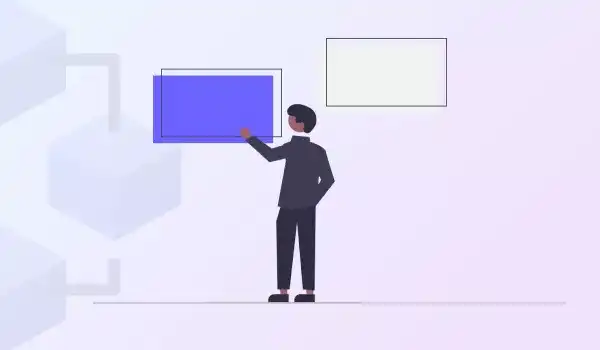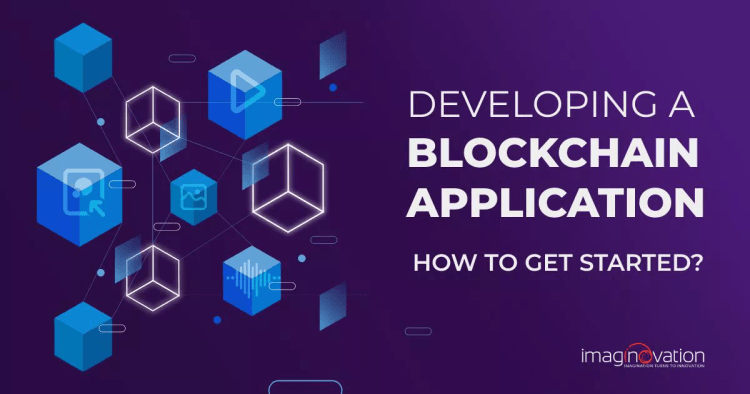Developing a blockchain app for your business is not simply a farsighted choice—it’s what will help you raise the bar in your business environment today.
Most business leaders are keen to find innovative ways to develop DApps (aka decentralized applications). It’s time you seriously consider blockchain app development.
With blockchain development, you can make your business processes highly secure, transparent, scalable, and globally accessible. There are many business applications of decentralized blockchain technology.
Are you thrilled to get started? Keep reading to find out how to develop a robust blockchain app for your business.
What are Blockchain Apps or DApps?
Let’s start with some basics.
When something is decentralized—it means that it isn’t owned, controlled, or managed by a single person or authority.
DApps or decentralized applications are an innovative breed of applications that are not owned or controlled by a single authority. The apps cannot be shut off or have downtime.
The concept of DApps is still at a nascent stage, but they are pretty like standard apps. They offer similar functions. However, the vital differentiator is that they run on a peer-to-peer network, such as blockchain.

Let’s take for example Twitter. When a user tweets something on Twitter, and it violates the community guidelines, the moderators delete the tweet. Imagine if there was a Twitter type DApp. It would mean decentralization and not owned by any one person. In such a scenario, when someone tweets, nobody would be able to delete it, including the creators.
Some essential features for DApps include:
- It must be open-source and must operate autonomously without anyone controlling it.
- It should be decentralized, and all data and records must be public.
- It must offer incentives to its users, including cryptographic tokens.
- It must have a specific protocol to demonstrate proof of value.
How Do DApps work?
So, how do they work?
A blockchain is a peer-to-peer network that’s purpose is to maintain an open ledger that records data. The data is chronologically stored in blocks and shared among its members.
So, if there is any data exchange or transaction in a blockchain network, everyone will have a record or copy of the action on their own devices.
The data blocks are associated with a chain. So, once they get linked to the chain, it would be impossible for anyone to make changes to it. The immutability feature makes a blockchain extraordinarily volatile and challenging to steal data from.
One can classify blockchain into two types based on the type of network.
1. Permissionless Blockchain
In this type, the blockchain is accessible to all the members of the network. Every member in the network has the right to access the code, interact with others, and verify transactions.
Members can do this while keeping their identity unknown. A great example of the permissionless blockchain type is Bitcoin.
2. Permissioned Blockchain
In the permissioned blockchain, only authorized users are allowed entry to the network. Every member in the blockchain network has their roles and permissions. Plus, the blockchain is regulated in light of a definite set of rules for transactions between the network members.
One can encounter this type of blockchain majorly for managing operations within organizations.
Why Does Your Business Need a Blockchain App?
Blockchain provides entrepreneurs multiple benefits to bring their business to the next level. It’s no wonder why the DApps are gaining popularity these days.
When it comes to some essential industries, one can find an upward trend in the use of DApps in businesses such as:
- Wallets
- Finance
- Games
- Exchanges
- Healthcare
- IoT startups
- Real estate
- Music industry
- Gambling
- E-mobility
Blockchain can revolutionize your business processes. Here are some benefits that will make you want to explore this technology more.

1. Improved Data Protection
DApps work on a shared database that replicates stored information across nodes in the chain.
So, hijacking a single node does not restrict the organization’s ability to vital access. Plus, it also does not mean that its data can be altered since every node in the blockchain would have to be hacked, and each individual ledger changed.
2. Open Source
One of the pre-requisites is that the DApp code should be open source (open access). The feature helps to make it transparent, helping everyone to verify the developers’ claims.
Every user can also access all the backend protocols, so developers can’t hide any back doors or separate data storage units that the users can’t access.
3. Easy to Integrate
When it comes to running DApps, all of them run on pre-existing blockchain technology like Ethereum.
The good part for developers is that no matter how sophisticated the DApp is to build, they don’t have to build the blockchain protocols that the DApp runs on. The facet helps reduce the developer’s efforts. Now, all they have to do is integrate their API with the blockchain platform’s API.
4. Decreased Reliance on Other Data Users’ Integrity
One of the features C-suite executives often seek is faster adoption of applications. DApps can help in quicker adoption.
How? Enterprise blockchain-based applications are typically designed to connect different organizations or trading partners.
So, even if a part of the solution is centralized, each organization must trust the entity controlling that part.
Moreover, fully decentralized applications don’t face the issue because a decentralized structure allows each party to run the app without trusting any other party.
5. Transparent Data
Most privacy laws and regulations vary from one country to the next. The centralized applications still require users to ask them for their own data.
On the other hand, DApps are on a public blockchain, so the information can’t be hidden.
6. Reduced Downtime
DApps are more robust and flexible than centralized applications because they don’t need to be connected to a single centralized server to run. So, enterprises can ensure minimal interruptions and downtime for maximum business continuity and resilience.
7. No Data Loss
When information is added to the blockchain, it gets stored permanently, which means DApps are more resistant to modifications or restrictions.
So, even if one of the nodes leaves the chain or is compromised somehow, it won’t matter. With decentralization, it means that the information will consistently get replicated on other terminals, so it’s pretty simple, one can never lose the data.
8. Impossible to Block
DApps are not hosted on any particular IP address. Considering there is more limited authority owning a DApp’s network, it is much more challenging for external authorities like hackers, national governments, and regulators to block a DApp.
9. Cost Reduction
DApps offer a higher transaction speed, which spells cost reduction. Organizations with centralized systems need to install heavy servers or hire experts to manage and maintain their servers and data. With decentralized systems, enterprises can save up on such costs.
Let us look at some compelling examples of using blockchain in different industries.
- IBM Blockchain: The best blockchain app in light of logistics companies and businesses with extended supply chains.
- Spotify: Uses a blockchain database for decentralized connection between Spotify artists, tracks, and licensing agreements.
- MedRec: A blockchain app focusing on healthcare that offers secure access to medical records across different entities, such as doctors, pharmacies, patients, and insurance companies.
- Warranteer: A retail company that uses blockchain to help clients access information on the products they buy and assists in getting service if the product has stopped working.
- Securrency: A trading platform for different kinds of cryptocurrencies, which also supports traditional assets that can be translated into Securrency exchange and tokens.
Getting Started with a Decentralized Blockchain App Development
Let’s find out more about the steps to develop a decentralized blockchain app.

Step 1. Ideation
Blockchain apps may be a buzz, and you don’t wish to jump on the bandwagon without clear ideas that offer viable business solutions.
So, the first step must always include the evaluation of ideas on the need for blockchain. You can start with listing the pain points, which you want to solve with your DApp. Next, move to formalize your idea.
Step 2. Conduct Market Research
Market research helps to collate essential data before moving with blockchain application development.
The collated data will give an idea of solutions that are available in the market. Plus, it can help with understanding how you can offer better solutions to win a competitive advantage.
Step 3. Select the Best Fit Consensus Mechanism
As a decentralized system, blockchain needs network nodes to authenticate the transaction. The process is called consensus.
So, for example, Bitcoin uses Proof of Work as a mechanism, which is also one of the most popular methods. However, you can also choose options like:
- Byzantine fault tolerance
- Delegated proof of stake
- Federated
- Proof of elapsed time
- Proof of stake
After placing the use cases aptly, you can select the best-fit consensus mechanism for the business processes.
Step 4. Analyze Options
It is good to know from a technical standpoint that there are four ways to develop a DApp for your business.
- Using open blockchains like Ethereum or Bitcoin
- Creating a private network considering blockchain software
- Considering the option of BaaS (Blockchain as a Service) provider, where one can select BaaS products from Azure, Amazon, Microsoft, and others. Plus, benefit from their cloud storage with integration into your app.
- Opt for a blockchain network of your own that you can develop on the platform best suited for your business.
Step 5. Identify the Platform
There are popular platforms for blockchain app development, and you can choose the one that fits your concept the best. Some top blockchain platforms include:
- Ethereum: Flexible and adaptable in nature.
- Multichain: Easy for mobile app developers to develop private blockchain solutions.
- Hyperledger: Used for creating advanced blockchain solutions, including IoT-based blockchain solutions.
- R3 Corda: Mostly focuses on commerce, healthcare, trade finance, and supply chain.
- Ripple: Great platform for anyone who plans to create a financial tool.
- EOS: Provides a solution that can offer decentralized application hosting, smart contract functionality, and decentralized storage for the enterprise solution.
- Quorum: Ethereum based open-source DLT and smart contract platform.
- IOTA: Used as an ideal platform for the development of payment systems.
Before choosing, you may want to consider a few factors that may help to navigate your choice.
- Nature of Platform: Identify the type of platform that caters to the business needs of your blockchain apps. It can be based on cryptocurrency or one that works on smart tokens, or even runs on multiple crypto tokens.
- Smart Contracts: Will your app need smart contracts to function? A smart contract is a self-executing protocol that validates or enforces a trigger-based action on the blockchain system.
- Consensus Protocol: Consider the various consensus protocols before you start with the blockchain app development.
- Cryptocurrency: Will you want to implement cryptocurrencies before opting to develop the blockchain app? The input can be one of the factors that affect how you choose the platform.
- Public or Private Network: Furthermore, check if you want to build a network accessible to everyone or one that is only editable by authorized users.
Step 6. Architecture Designing
Blockchain solutions can be facilitated via in-house, cloud, or in a hybrid model. Plus, one can choose from various hardware and software configurations, such as operating systems, processors, memory, disk size, and more.
Considering this backdrop, developers must ensure that the entire architecture complements the high-level requirements of the blockchain app.
Step 7. Start the Development Process
After looking at several facets, such as language, platform, the strategy of interactions, and the consensus mechanism, you can focus on the development process.
The development phase typically consists of the stages, including:
- Business analysis: Business analysts will create a technical specification based on requirements, expectations, and business goals. The document details the people responsible for development and communication to frameworks, operating systems, and libraries.
- Design: The complexity of each project may vary, and depending on the design complexity, it can take from 8% to 20% of the total development budget.
- Preparation: The development environment is set up, including APIs, architecture, and backend.
- Development and Quality Assurance: Before deployment, it is critical to work on QA on the developed modules. A QA engineer will run a regression test to check the functioning of the modules/project.
- Deployment: Before deployment, an app must comply with all Apple App Store or Google Play Store rules and conditions. After deployment, it is significant to analyze both performance data and user analytics.
- Maintenance and Support: The stage includes updates to libraries, frameworks, and operating systems. Plus, it will involve implementing new features and making changes to the app as per the current business needs.
Step 8. Deploy and Maintain the Blockchain App
Deployment is the final step of the development process. So, when the app is ready, it will hit the markets and be revealed to the world on the Google Play Store, Apple App Store, or other app markets. The stage is an excellent opportunity to gather data in your DApp and check out how users respond to it.
Another critical stage is maintenance, which is essential to the blockchain app development services. You will need to update the app frequently to support new versions of libraries and operating systems.
Integrating the Blockchain App with Your Business
After the arduous development of your blockchain application, the next question is to integrate it into your business process.
It is critical to benefit from increased revenue, improved security, and optimized digital business operations. Here are some exciting facets.
1. Authentication
For executive leaders looking for a secure tool for internal communication or operational management, a blockchain is a safe and go-to tool.
With its unparalleled security, it allows access only for authorized users. Plus, you get the opportunity to manipulate access levels in permissioned blockchain.
2. For Transactions
When it comes to transactions, the typical gateways work great. However, suppose your target audience is aware of cryptocurrencies.
In that case, you may want to incorporate blockchain as it is the best way to offer secure, fast, and easy cryptocurrency transactions for payments.
3. For Supply Chain Management
The supply chain mechanism typically involves exchanges of components between diverse entities.
In such cases, blockchain technology can be an excellent tool for offering safe and permanent auditable records to look over the complete processing.
4. Use As a Distributed Cloud Storage
One can consider the use of blockchain applications as decentralized cloud storage. Instead of allocating cloud storage for your application, you may choose blockchain technology and offer users fast and convenient cloud storage.
Wrapping Up
Decentralized apps have some exciting trends to watch out for in 2021. The trends include improved UI and UX, more NFT (non-fungible tokens), decentralized finance (DeFi) DApps, and video game DApps.
With such thrilling trends, business leaders must tap the potential of DApps and win a competitive edge. The key is to innovate and develop viable solutions to make the business landscape more robust and resilient.
Develop Robust Blockchain Apps with Imaginovation
Do you want to build a blockchain app for your business? If you wish to design and develop robust blockchain solutions, get in touch with us.
We are an award-winning web and mobile app development company in Raleigh with vast experience in emerging technologies such as blockchain, AI, AR, and VR.
Let’s talk.
Ready to build an app, but not sure where to start?
We've got you covered. Click the button below to get started.





